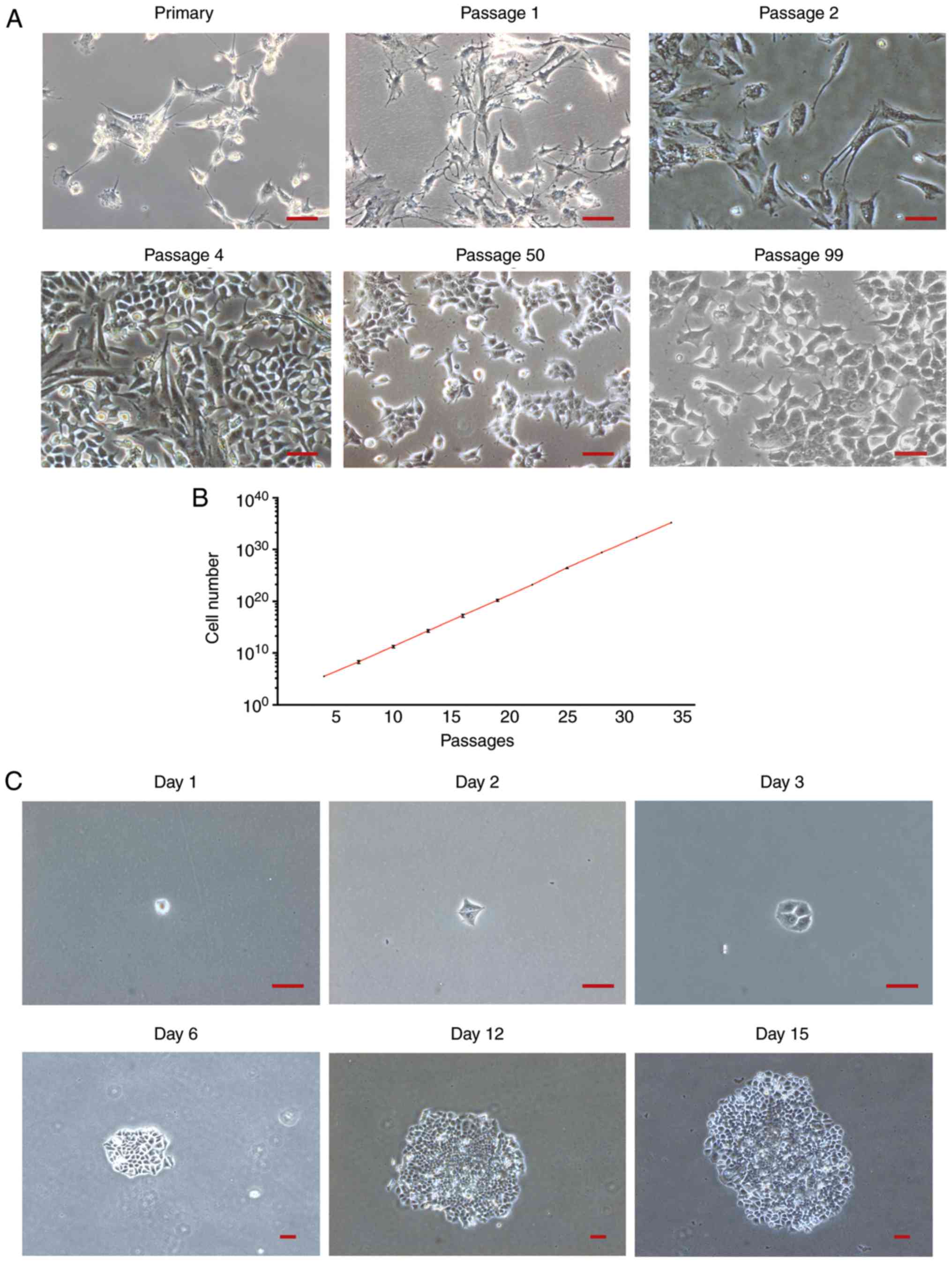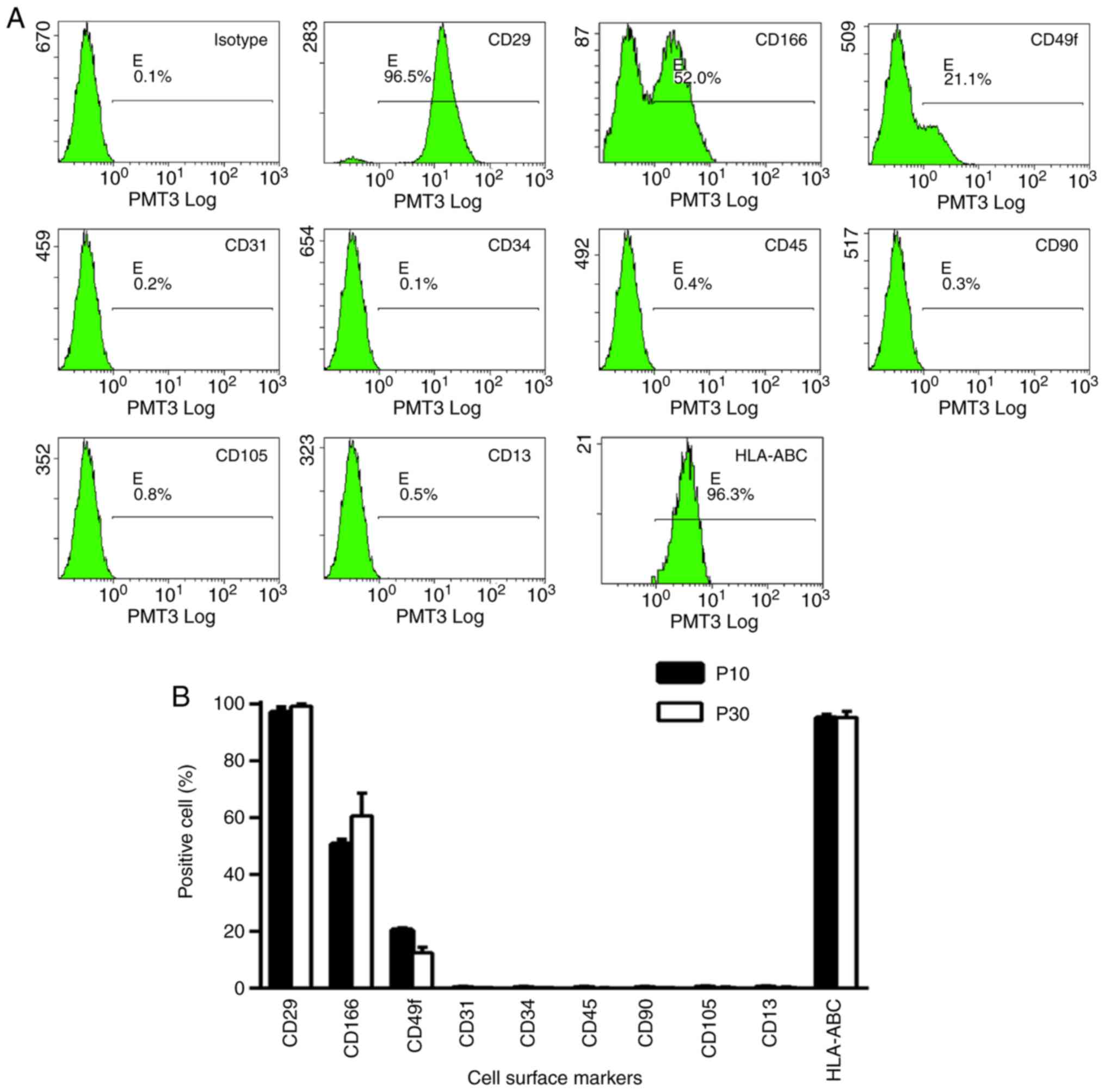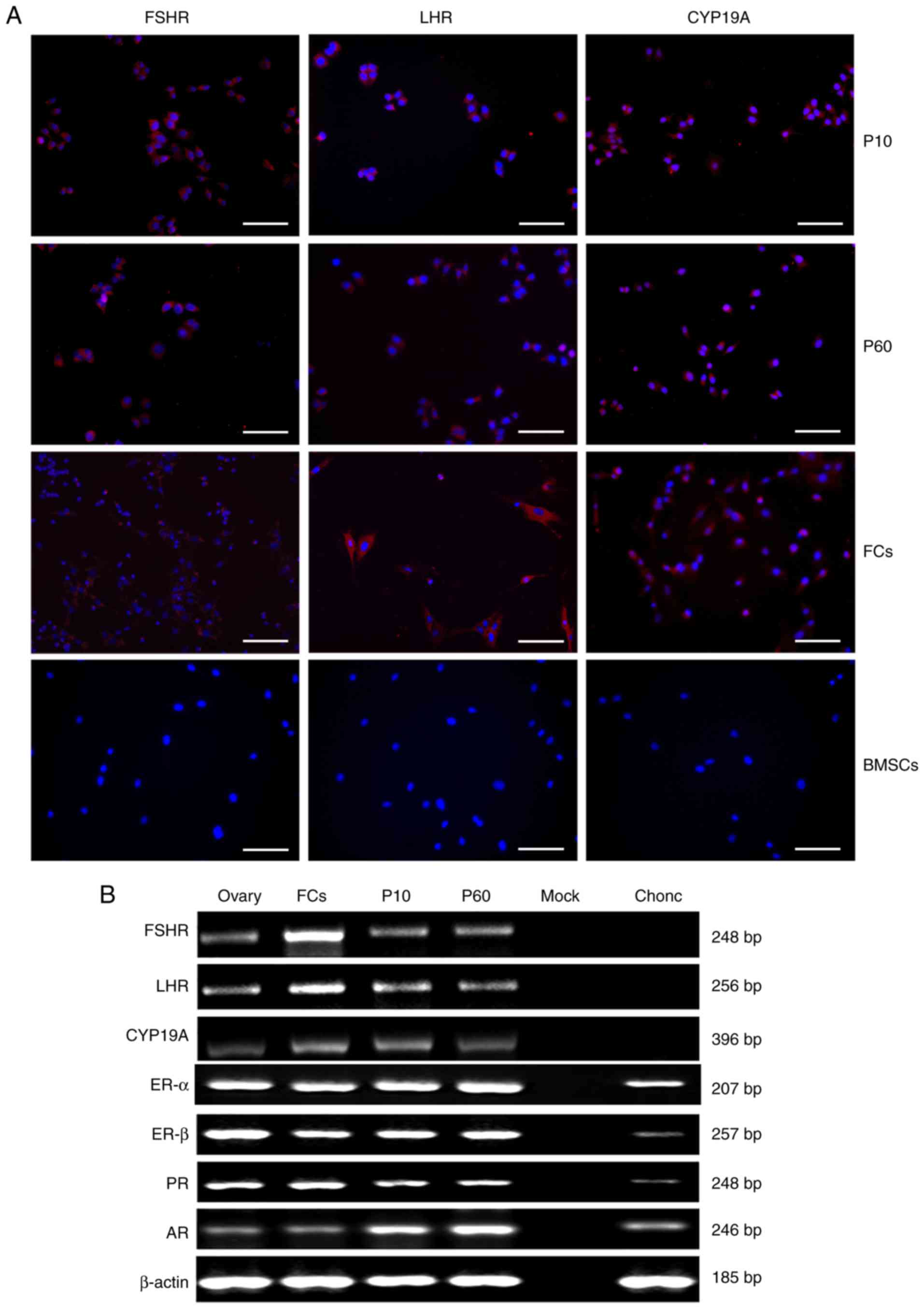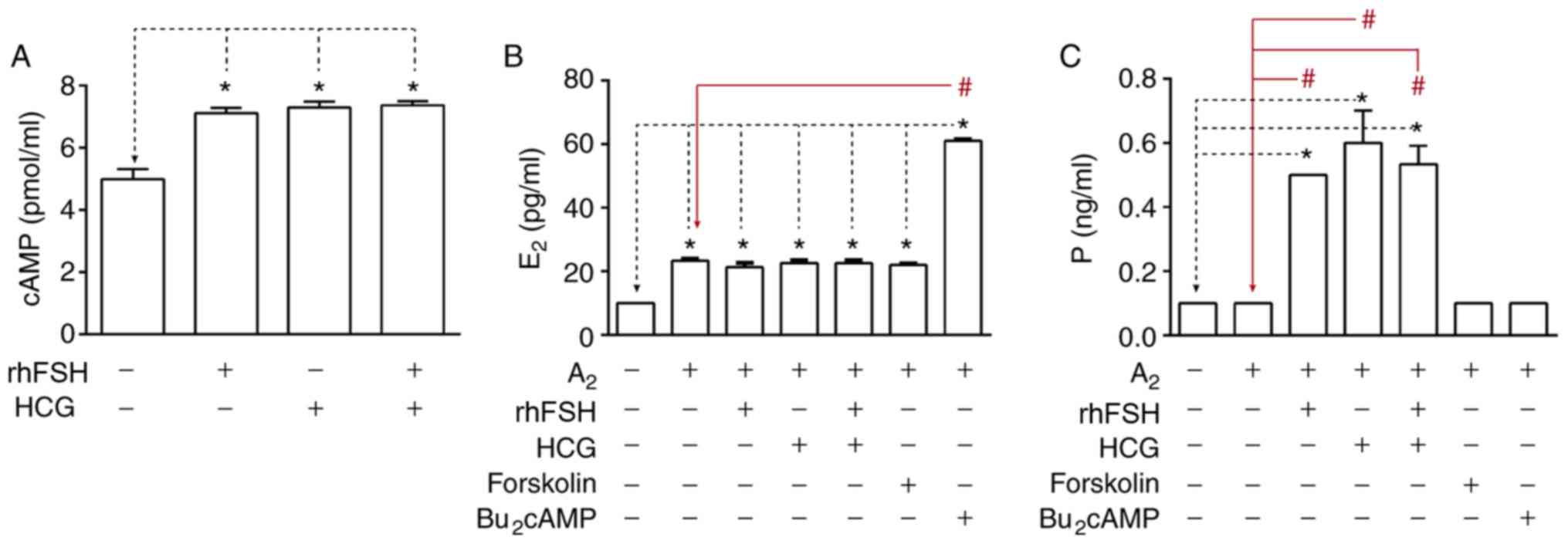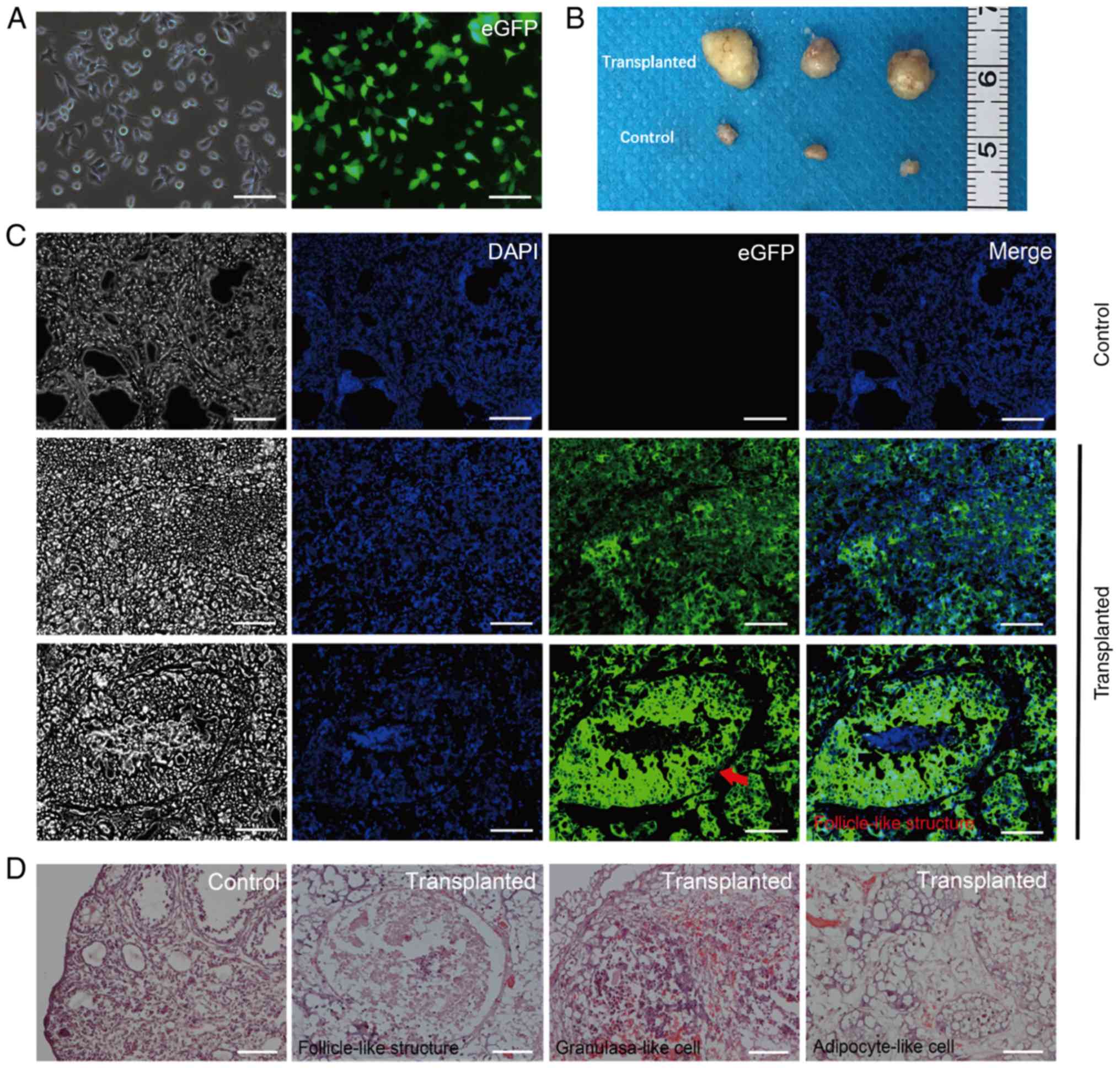|
1
|
Senbon S, Hirao Y and Miyano T:
Interactions between the oocyte and surrounding somatic cells in
follicular development: Lessons from in vitro culture. J Reprod
Dev. 49:259–269. 2003. View Article : Google Scholar : PubMed/NCBI
|
|
2
|
Dzafic E, Stimpfel M and Virant-Klun I:
Plasticity of granulosa cells: On the crossroad of stemness and
transdifferentiation potential. J Assist Reprod Genet.
30:1255–1261. 2013. View Article : Google Scholar : PubMed/NCBI
|
|
3
|
Kossowska-Tomaszczuk K, De Geyter C, De
Geyter M, Martin I, Holzgreve W, Scherberich A and Zhang H: The
multipotency of luteinizing granulosa cells collected from mature
ovarian follicles. Stem Cells. 27:210–219. 2009. View Article : Google Scholar : PubMed/NCBI
|
|
4
|
Gougeon A: Regulation of ovarian
follicular development in primates: Facts and hypotheses. Endocr
Rev. 17:121–155. 1996. View Article : Google Scholar : PubMed/NCBI
|
|
5
|
Niswender GD, Juengel JL, Silva PJ,
Rollyson MK and McIntush EW: Mechanisms controlling the function
and the life span of the corpus luteum. Physiol Rev. 80:1–29. 2000.
View Article : Google Scholar : PubMed/NCBI
|
|
6
|
Lavranos TC, Rodgers HF, Bertoncello I and
Rodgers RJ: Anchorage-independent culture of bovine granulosa
cells: The effects of basic fibroblast growth factor and dibutyryl
cAMP on cell division and differentiation. Exp Cell Res.
211:245–251. 1994. View Article : Google Scholar : PubMed/NCBI
|
|
7
|
Van Deerlin PG, Cekleniak N, Coutifaris C,
Boyd J and Strauss JF 3rd: Evidence for the oligoclonal origin of
the granulosa cell population of the mature human follicle. J Clin
Endocrinol Metab. 82:3019–3024. 1997. View Article : Google Scholar : PubMed/NCBI
|
|
8
|
Lavranos TC, Mathis JM, Latham SE,
Kalionis B, Shay JW and Rodgers RJ: Evidence for ovarian granulosa
stem cells: Telomerase activity and localization of the telomerase
ribonucleic acid component in bovine ovarian follicles. Biol
Reprod. 61:358–366. 1999. View Article : Google Scholar : PubMed/NCBI
|
|
9
|
Bukovsky A, Caudle MR and Svetlikova M:
Steroid-mediated differentiation of neural/neuronal cells from
epithelial ovarian precursors in vitro. Cell Cycle. 7:3577–3583.
2008. View Article : Google Scholar : PubMed/NCBI
|
|
10
|
Bukovsky A, Gupta SK, Virant-Klun I,
Upadhyaya NB, Copas P, Van Meter SE, Svetlikova M, Ayala ME and
Dominguez R: Study origin of germ cells and formation of new
primary follicles in adult human and rat ovaries. Methods Mol Biol.
450:233–265. 2008. View Article : Google Scholar : PubMed/NCBI
|
|
11
|
Virant-Klun I, Zech N, Rozman P, Vogler A,
Cvjeticanin B, Klemenc P, Malicev E and Meden-Vrtovec H: Putative
stem cells with an embryonic character isolated from the ovarian
surface epithelium of women with no naturally present follicles and
oocytes. Differentiation. 76:843–856. 2008. View Article : Google Scholar : PubMed/NCBI
|
|
12
|
Varras M, Griva T, Kalles V, Akrivis C and
Paparisteidis N: Markers of stem cells in human ovarian granulosa
cells: Is there a clinical significance in ART? J Ovarian Res.
5:362012. View Article : Google Scholar : PubMed/NCBI
|
|
13
|
Kossowska-Tomaszczuk K and De Geyter C:
Cells with stem cell characteristics in somatic compartments of the
ovary. Biomed Res Int. 2013:3108592013. View Article : Google Scholar : PubMed/NCBI
|
|
14
|
Kossowska-Tomaszczuk K, Pelczar P, Güven
S, Kowalski J, Volpi E, De Geyter C and Scherberich A: A novel
three-dimensional culture system allows prolonged culture of
functional human granulosa cells and mimics the ovarian
environment. Tissue Eng Part A. 16:2063–2073. 2010. View Article : Google Scholar : PubMed/NCBI
|
|
15
|
Bruckova L, Soukup T, Visek B, Moos J,
Moosova M, Pavelkova J, Rezabek K, Kucerova L, Micuda S, Brcakova E
and Mokry J: Proliferative potential and phenotypic analysis of
long-term cultivated human granulosa cells initiated by addition of
follicular fluid. J Assist Reprod Genet. 28:939–950. 2011.
View Article : Google Scholar : PubMed/NCBI
|
|
16
|
Evans MJ and Kaufman MH: Establishment in
culture of pluripotential cells from mouse embryos. Nature.
292:154–156. 1981. View Article : Google Scholar : PubMed/NCBI
|
|
17
|
Lim JW and Bodnar A: Proteome analysis of
conditioned medium from mouse embryonic fibroblast feeder layers
which support the growth of human embryonic stem cells. Proteomics.
2:1187–1203. 2002. View Article : Google Scholar : PubMed/NCBI
|
|
18
|
Shi YT, Huang YZ, Tang F and Chu JX: Mouse
embryonic stem cell-derived feeder cells support the growth of
their own mouse embryonic stem cells. Cell Biol Int. 30:1041–1047.
2006. View Article : Google Scholar : PubMed/NCBI
|
|
19
|
Kuang Y, Chen Q, Fu Y, Wang Y, Hong Q, Lyu
Q, Ai A and Shoham Z: Medroxyprogesterone acetate is an effective
oral alternative for preventing premature luteinizing hormone
surges in women undergoing controlled ovarian hyperstimulation for
in vitro fertilization. Fertil Steril. 104:62–70 e63. 2015.
View Article : Google Scholar : PubMed/NCBI
|
|
20
|
Zhang L, He A, Yin Z, Yu Z, Luo X, Liu W,
Zhang W, Cao Y, Liu Y and Zhou G: Regeneration of human-ear-shaped
cartilage by co-culturing human microtia chondrocytes with BMSCs.
Biomaterials. 35:4878–4887. 2014. View Article : Google Scholar : PubMed/NCBI
|
|
21
|
Chen Y, Ai A, Tang ZY, Zhou GD, Liu W, Cao
Y and Zhang WJ: Mesenchymal-like stem cells derived from human
parthenogenetic embryonic stem cells. Stem Cells Dev. 21:143–151.
2012. View Article : Google Scholar : PubMed/NCBI
|
|
22
|
Baroffio A, Dupin E and Le Douarin NM:
Clone-forming ability and differentiation potential of migratory
neural crest cells. Proc Natl Acad Sci USA. 85:5325–5329. 1988.
View Article : Google Scholar : PubMed/NCBI
|
|
23
|
Gan Y, Dai K, Zhang P, Tang T, Zhu Z and
Lu J: The clinical use of enriched bone marrow stem cells combined
with porous beta-tricalcium phosphate in posterior spinal fusion.
Biomaterials. 29:3973–3982. 2008. View Article : Google Scholar : PubMed/NCBI
|
|
24
|
Xu C, Inokuma MS, Denham J, Golds K, Kundu
P, Gold JD and Carpenter MK: Feeder-free growth of undifferentiated
human embryonic stem cells. Nat Biotechnol. 19:971–974. 2001.
View Article : Google Scholar : PubMed/NCBI
|
|
25
|
Liu L, Peng Z, Xu Z, Huang H and Wei X:
Mouse embryonic fibroblast (MEF)/BMP4-conditioned medium enhanced
multipotency of human dental pulp cells. J Mol Histol. 49:17–26.
2018. View Article : Google Scholar : PubMed/NCBI
|
|
26
|
Ferrero H, Delgado-Rosas F, Garcia-Pascual
CM, Monterde M, Zimmermann RC, Simón C, Pellicer A and Gómez R:
Efficiency and purity provided by the existing methods for the
isolation of luteinized granulosa cells: A comparative study. Hum
Reprod. 27:1781–1789. 2012. View Article : Google Scholar : PubMed/NCBI
|
|
27
|
Beckmann MW, Polacek D, Seung L and
Schreiber JR: Human ovarian granulosa cell culture: Determination
of blood cell contamination and evaluation of possible culture
purification steps. Fertil Steril. 56:881–887. 1991. View Article : Google Scholar : PubMed/NCBI
|
|
28
|
Thorsby E: A short history of HLA. Tissue
Antigens. 74:101–116. 2009. View Article : Google Scholar : PubMed/NCBI
|
|
29
|
Dzafic E, Stimpfel M, Novakovic S,
Cerkovnik P and Virant-Klun I: Expression of mesenchymal stem
cells-related genes and plasticity of aspirated follicular cells
obtained from infertile women. Biomed Res Int. 2014:5082162014.
View Article : Google Scholar : PubMed/NCBI
|
|
30
|
Rice S, Elia A, Jawad Z, Pellatt L and
Mason HD: Metformin inhibits follicle-stimulating hormone (FSH)
action in human granulosa cells: Relevance to polycystic ovary
syndrome. J Clin Endocrinol Metab. 98:E1491–E1500. 2013. View Article : Google Scholar : PubMed/NCBI
|
|
31
|
James K, Bhartiya D, Ganguly R, Kaushik A,
Gala K, Singh P and Metkari SM: Gonadotropin and steroid hormones
regulate pluripotent very small embryonic-like stem cells in adult
mouse uterine endometrium. J Ovarian Res. 11:832018. View Article : Google Scholar : PubMed/NCBI
|
|
32
|
Kumar TR: Extragonadal FSH receptor: Is it
real? Biol Reprod. 91:992014. View Article : Google Scholar : PubMed/NCBI
|
|
33
|
Kumar TR: Extragonadal actions of FSH: A
critical need for novel genetic models. Endocrinology. 159:2–8.
2018. View Article : Google Scholar : PubMed/NCBI
|
|
34
|
Allan CM, Kalak R, Dunstan CR, McTavish
KJ, Zhou H, Handelsman DJ and Seibel MJ: Follicle-stimulating
hormone increases bone mass in female mice. Proc Natl Acad Sci USA.
107:22629–22634. 2010. View Article : Google Scholar : PubMed/NCBI
|
|
35
|
Stelmaszewska J, Chrusciel M, Doroszko M,
Akerfelt M, Ponikwicka-Tyszko D, Nees M, Frentsch M, Li X, Kero J,
Huhtaniemi I, et al: Revisiting the expression and function of
follicle-stimulation hormone receptor in human umbilical vein
endothelial cells. Sci Rep. 6:370952016. View Article : Google Scholar : PubMed/NCBI
|
|
36
|
Davis MR and Summers KM: Structure and
function of the mammalian fibrillin gene family: Implications for
human connective tissue diseases. Mol Genet Metab. 107:635–647.
2012. View Article : Google Scholar : PubMed/NCBI
|
|
37
|
Méduri G, Charnaux N, Driancourt MA,
Combettes L, Granet P, Vannier B, Loosfelt H and Milgrom E:
Follicle-stimulating hormone receptors in oocytes. J Clin
Endocrinol Metab. 87:2266–2276. 2002. View Article : Google Scholar : PubMed/NCBI
|
|
38
|
Havelock JC, Rainey WE and Carr BR:
Ovarian granulosa cell lines. Mol Cell Endocrinol. 228:67–78. 2004.
View Article : Google Scholar : PubMed/NCBI
|
|
39
|
Rainey WH, Sawetawan C, Shay JW, Michael
MD, Mathis JM, Kutteh W, Byrd W and Carr BR: Transformation of
human granulosa cells with the E6 and E7 regions of human
papillomavirus. J Clin Endocrinol Metab. 78:705–710. 1994.
View Article : Google Scholar : PubMed/NCBI
|
|
40
|
Tsutsumi R, Hiroi H, Momoeda M, Hosokawa
Y, Nakazawa F, Koizumi M, Yano T, Tsutsumi O and Taketani Y:
Inhibitory effects of cholesterol sulfate on progesterone
production in human granulosa-like tumor cell line, KGN. Endocr J.
55:575–581. 2008. View Article : Google Scholar : PubMed/NCBI
|
|
41
|
Bayasula, Iwase A, Kiyono T, Takikawa S,
Goto M, Nakamura T, Nagatomo Y, Nakahara T, Kotani T, Kobayashi H,
et al: Establishment of a human nonluteinized granulosa cell line
that transitions from the gonadotropin-independent to the
gonadotropin-dependent status. Endocrinology. 153:2851–2860. 2012.
View Article : Google Scholar : PubMed/NCBI
|
|
42
|
van den Berg-Bakker CA, Hagemeijer A,
Franken-Postma EM, Smit VT, Kuppen PJ, van Ravenswaay Claasen HH,
Cornelisse CJ and Schrier PI: Establishment and characterization of
7 ovarian carcinoma cell lines and one granulosa tumor cell line:
Growth features and cytogenetics. Int J Cancer. 53:613–620. 1993.
View Article : Google Scholar : PubMed/NCBI
|
|
43
|
Zhang H, Vollmer M, De Geyter M,
Litzistorf Y, Ladewig A, Dürrenberger M, Guggenheim R, Miny P,
Holzgreve W and De Geyter C: Characterization of an immortalized
human granulosa cell line (COV434). Mol Hum Reprod. 6:146–153.
2000. View Article : Google Scholar : PubMed/NCBI
|
|
44
|
Kondo H, Kiguchi K, Okamura A, Okuma Y,
Iida T, Kobayashi Y, Takagi M, Ishizuka B and Ishiwata I:
Establishment and characterization of a human ovarian granulosa
tumor cell line (HSOGT). Hum Cell. 16:123–129. 2003. View Article : Google Scholar : PubMed/NCBI
|
|
45
|
Lie BL, Leung E, Leung PC and Auersperg N:
Long-term growth and steroidogenic potential of human
granulosa-lutein cells immortalized with SV40 large T antigen. Mol
Cell Endocrinol. 120:169–176. 1996. View Article : Google Scholar : PubMed/NCBI
|
|
46
|
Hosokawa K, Dantes A, Schere-Levy C,
Barash A, Yoshida Y, Kotsuji F, Vlodavsky I and Amsterdam A:
Induction of Ad4BP/SF-1, steroidogenic acute regulatory protein,
and cytochrome P450scc enzyme system expression in newly
established human granulosa cell lines. Endocrinology.
139:4679–4687. 1998. View Article : Google Scholar : PubMed/NCBI
|
|
47
|
Tajima K, Hosokawa K, Yoshida Y, Dantes A,
Sasson R, Kotsuji F and Amsterdam A: Establishment of
FSH-responsive cell lines by transfection of pre-ovulatory human
granulosa cells with mutated p53 (p53val135) and Ha-ras genes. Mol
Hum Reprod. 8:48–57. 2002. View Article : Google Scholar : PubMed/NCBI
|
|
48
|
Nishi Y, Yanase T, Mu Y, Oba K, Ichino I,
Saito M, Nomura M, Mukasa C, Okabe T, Goto K, et al: Establishment
and characterization of a steroidogenic human granulosa-like tumor
cell line, KGN, that expresses functional follicle-stimulating
hormone receptor. Endocrinology. 142:437–445. 2001. View Article : Google Scholar : PubMed/NCBI
|
|
49
|
Okamura H, Katabuchi H and Ohba T: What we
have learned from isolated cells from human ovary? Mol Cell
Endocrinol. 202:37–45. 2003. View Article : Google Scholar : PubMed/NCBI
|
|
50
|
Nguyen TD, Filliatreau L, Klett D and
Combarnous Y: Comparative effects of sub-stimulating concentrations
of non-human versus human Luteinizing Hormones (LH) or chorionic
gonadotropins (CG) on adenylate cyclase activation by forskolin in
MLTC cells. Gen Comp Endocrinol. 261:23–30. 2018. View Article : Google Scholar : PubMed/NCBI
|
|
51
|
Reed BG and Carr BR: The Normal Menstrual
Cycle and the Control of Ovulation. Endotext [Internet]. Feingold
KR, Anawalt B, Boyce A, et al: MDText.com; South Dartmouth, MA:
2000
|
|
52
|
Gloaguen P, Crépieux P, Heitzler D, Poupon
A and Reiter E: Mapping the follicle-stimulating hormone-induced
signaling networks. Front Endocrinol (Lausanne). 2:452011.
View Article : Google Scholar : PubMed/NCBI
|
|
53
|
Virant-Klun I, Rozman P, Cvjeticanin B,
Vrtacnik-Bokal E, Novakovic S, Rülicke T, Dovc P and Meden-Vrtovec
H: Parthenogenetic embryo-like structures in the human ovarian
surface epithelium cell culture in postmenopausal women with no
naturally present follicles and oocytes. Stem Cells Dev.
18:137–149. 2009. View Article : Google Scholar : PubMed/NCBI
|















